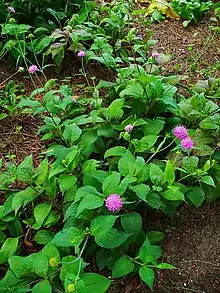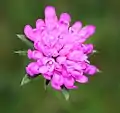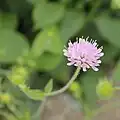Knautia drymeia
Knautia drymeia, commonly known as the Hungarian widow flower,[2] is a herbaceous perennial plant species in the family Caprifoliaceae,[3] that grows in Central and Southeastern Europe.[4]
| Knautia drymeia | |
|---|---|
 | |
| Scientific classification | |
| Kingdom: | Plantae |
| Clade: | Tracheophytes |
| Clade: | Angiosperms |
| Clade: | Eudicots |
| Clade: | Asterids |
| Order: | Dipsacales |
| Family: | Caprifoliaceae |
| Genus: | Knautia |
| Species: | K. drymeia |
| Binomial name | |
| Knautia drymeia Heuff., 1856[1] | |
| Synonyms[1] | |
| |
Taxonomy
This species was first formally described by Austrian botanist Johann Heuffel in his work Flora 39 in 1856.[5]
There are a few recognized subspecies of Knautia drymeia:[1]
Description
This upright-growing perennial widow flower can reach from 40 to 60 centimetres of height and is easily recognizable because of its leaf rosette, that gives rise to multiple flowering stems. The species's stem is hirsute, with leaves growing along the entire length.[3] Its oppositely arranged simple and entire leaves are in most cases petiolate, covered with trichomes and lanceolate to ovate in shape.[3][6] There are no stipules.[6]
Knautia drymeia is known as a very morphologically variable species.[7] The species' subspecies can be recognized by their vegetative parts, especially their leaves' characteristics. In subspecies drymeia stem leaves are ovate to ovate-lanceolate in shape, while basal leaves have whiteish bristles. On the other hand, subspecies intermedia can be determined by yellowish bristles of basal leaves, while its stem leaves are either oblong either lanceolate. Subspecies tergestina has similarly coloured bristles of basal leaves as ssp. drymeia (white to gray), but its stem leaves are round to widely ovate and deeply serrated.[3]
Its flowers are united into so-called calathidium inflorescences, that are surrounded by lanceolate involucral leaves. Each zygomorphic flower consists of four floral leaves, with petals being scarlet, scarlet red, purple and in rare cases even white. The plant's sepals are reduced into very short and pointy flower bristles, that are usually in groups of 8. Knautia drymeia has so-called inferior ovary, with flower elements being set above it.[3]
Knautia drymeia flowers between June and September and is pollinated by insects (entomophily). Its hirsute fruit is so-called achene[6] and reaches from 4 to 5 mm of length.[4] Layman can mistake Knautia drymeia with similar widow flowers, such as the common Knautia arvensis[3] and Knautia dipsacifolia.[4]
This species chromosome number is 2n = 40,[6] with plants being polyploid; either diploid either tetraploid.[7]
Distribution and habitat
Knautia drymeia is a European species that prefers southern temperate and submeridional floristic zones,[6] with its distribution area consisting of central and southeastern European countries.[4] This relatively common widow flower can be found growing in various shaded forests with dense undergrowth, on the forest edges, as well as different meadows.[3] Only rarely Knautia drymeia represents a part of anthropogenic vegetation.[6]
The Raunkiær system classifies it as a hemicryptophyte species.[6]
Gallery
References
- "Knautia drymeia Heuff". www.gbif.org. Retrieved 2021-09-03.
- "Knautia drymeia ssp. drymeia (Hungarian Widow Flower) --- Rareplants.eu". www.rareplants.de. Retrieved 2021-09-03.
- "Ogrsko grabljišče - Urbanatura". www.urbanatura.si (in Slovenian). Retrieved 2021-09-03.
- "Art Info: Knautia drymeia". www.infoflora.ch. Retrieved 2021-09-03.
- "Flora Croatica Database : 26530". hirc.botanic.hr. Retrieved 2021-09-03.
- Data: Knautia drymeia. Pladias – Database of the Czech Flora and Vegetation. www.pladias.cz. Retrieved 3. September 2021.
- Rešetnik, Ivana; Frajman, Božo; Schönswetter, Peter (2016). "Heteroploid Knautia drymeia includes K. gussonei and cannot be separated into diagnosable subspecies". American Journal of Botany. 103 (7): 1300–1313. doi:10.3732/ajb.1500506. ISSN 0002-9122. PMID 27425632.
External links
 Data related to Knautia drymeia at Wikispecies
Data related to Knautia drymeia at Wikispecies Media related to Knautia drymeia at Wikimedia Commons
Media related to Knautia drymeia at Wikimedia Commons







